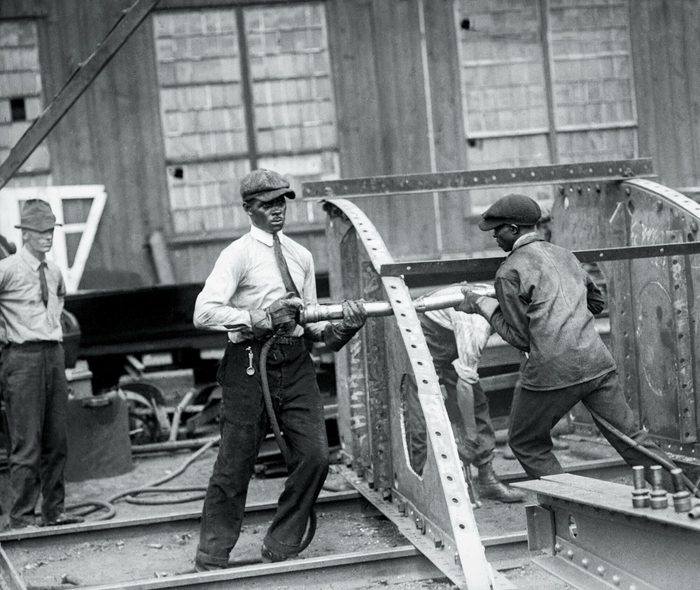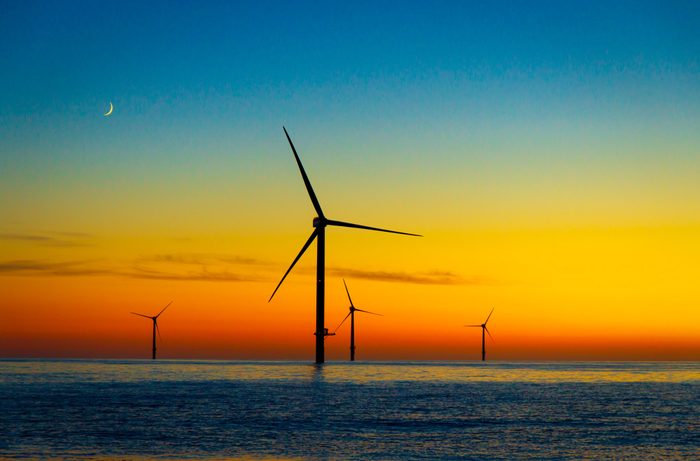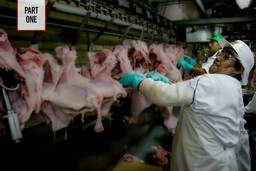This Old Steel Mill Town is Now a Hub for Green Energy
Sick of poison runoff and toxic beaches, a former steel town near Baltimore fights for clean jobs.
Dharna Noor

Larry Bannerman was 11 when his neighborhood, Turner Station, got its own beach in spring of 1964. “On opening day, it was a madhouse,” he said. “You could just barely see the water, it was so many people.”
Across the water was the old steel mill, Bethlehem Steel, where his father and uncle worked. From the beach, its smokestacks looked like birthday candles that had just been blown out.
Bannerman’s brother, Butch, got a job as a lifeguard. But within months, Butch began getting large lesions on his face and infections that made his ear swell to four times its normal size. He wasn’t the only one. The town’s doctors called up the county health department, which agreed that the water was contaminated. People suspected the steel mill’s runoff had something to do with it; they had seen how the facility’s emissions filled the sky with thick orange dust that made it hard to breathe. (Water-quality studies confirmed their suspicions years later.)
By the following summer, county officials closed the beach. But the mill remained open, spewing toxins into the air and water and exposing thousands of nearby residents and workers to lead, asbestos, sulfuric acid and other chemicals that increased their risk of respiratory disease and cancer.
***
Turner Station is a Black enclave in Sparrows Point, a mostly white, unincorporated community just southeast of Baltimore. Sparrows Point’s Bethlehem Steel mill, once the largest in the world, employed 30,000 people at its height in the late 1950s.
Back then, Bannerman estimates, more than 80 percent of the men in Turner Station worked at the plant, including his father. He would come home each day and collapse in the living room, exhausted and short of breath. Often, he’d only have eight hours off between shifts. He died just two years after he retired.

Bannerman’s mother was a member of the Turner Station Development Corporation, founded in the 1970s to fight for tenants’ rights, pushing the absentee landlords and administrators of the two big housing complexes in the neighborhood to address the asbestos-filled walls and faulty electricity. The tenants later turned to other issues of fair development, pushing officials to replace broken sidewalks and drainpipes. The one entity they never went up against was Bethlehem Steel. “My mother and father used to argue,” Bannerman said. “My father would say, ‘Don’t make waves. I need my job.’ ”
Bannerman was the only man in his family who didn’t get a job at the mill. “Just looking at my dad, I made my mind up I wouldn’t spend my life working like that,” he said. Instead, he worked for Baltimore Gas and Electric as a utility worker and then as an electrician.
By the mid-2000s, the mill was cutting operations and laying off workers by the thousands. The industry was changing. The United States was beginning to favor imported steel from Europe and Asia. Bannerman’s brother, Butch, who worked at the mill, accepted a buyout equal to just a fraction of his yearly salary. His union’s membership funds were dwindling, so his pension got cut in half. In 2012, the mill closed for good, leaving unemployment and environmental devastation in its wake. The contaminated air, soil and water left residents with increased rates of cancer, respiratory disease and birth defects.
Bannerman, retired, is now in his mid-60s. He still lives in his old neighborhood and sits on the board of Turner Station Conservation Teams (the successor to the Turner Station Development Corporation), a local environmental group that works to clean, depollute and beautify the area and ensure that new development projects are environmentally just. They’ve formed many alliances, some less likely than others. To procure needed streetlights, for instance, Bannerman relied on relationships with
employees at his former employer, Baltimore Gas and Electric, which provides mostly fossil-based energy. “That wasn’t even BG&E’s domain; the guys who came in just did it as an act of good will.”
***
Today, Turner Station Conservation Teams is led by a group of volunteer Black retirees from the neighborhood, and Bannerman spearheads their environmental work. With Maryland Environmental Health Network, which has a research budget and staff, the organization successfully pressured corporations to re-line leaky storm drains under a local shipping facility that were spilling carcinogenic chromium into waterways. With green groups Clean Water Action, Chesapeake Climate Action Network, and the Environmental Integrity Project—groups with fulltime organizers and national connections — they worked on a successful ban on crude oil terminals. On other issues, they played a supporting role: Bannerman assisted the youth-led environmental organization Free Your Voice and worker justice group United Workers with outreach in their successful fight against a proposed trash incinerator.
The struggles were diverse, but most were about what they didn’t want. So Bannerman was curious when he heard that two companies had proposed separately to construct offshore wind energy farms in Maryland’s coastal waters. Deepwater Wind was proposing a 120-megawatt project that they called the Skipjack Wind Farm. U.S. Wind’s proposal would generate more than six times that. Bannerman was even more intrigued when he learned that the projects included a possible new steel fabrication facility in Sparrows Point where the old steel mill once stood.
In summer 2016, a representative from U.S. Wind came to a Turner Station Conservation Teams meeting. He said his company’s proposed wind project could employ thousands. Its turbines would be made from imported steel, so fabrication plant workers would only be responsible for assembly and wouldn’t be exposed to as many harmful pollutants — a major plus for Bannerman. And U.S. Wind had the support of local unions, which could ensure workers had safe working conditions and fair wages.
Bannerman knew the projects wouldn’t be perfect. Health regulations had gotten stricter since Bethlehem Steel closed down, but imported steel still meant that somewhere people would be exposed to dangerous chemicals. The facility where the turbines’ fiberglass and resin blades were manufactured could still include smokestacks, though far fewer than those at Bethlehem Steel. U.S. Wind’s project could put thousands back to work, but some of those jobs would be temporary — some people would be out of work once construction was complete.
Nevertheless, Bannerman and the Conservation Teams were on board. If U.S. Wind’s project was approved, they could eventually expand it, employing more people to set up more turbines that could create more clean energy. Other developers might follow suit and build new wind farms in the state. Maryland could become a leader in the new clean energy economy.
To Bannerman, this seemed like an obvious win. But he would soon learn that not everyone agreed.
On a cloudy Saturday in March 2017, Bannerman drove two and a half hours to a middle school on Maryland’s Eastern Shore — 10 miles from Ocean City, where the turbines would be built — to testify at a Maryland Public Service Commission (PSC) meeting about the competing wind proposals. They met in the gymnasium, where the scene resembled a school assembly, with five state commissioners seated on the stage in suits and ties, and dozens of business representatives, union leaders and environmental organizers from local groups such as the Chesapeake Climate Action Network, regional ones such as Clean Water Action, and national ones such as Earthjustice, seated below.
Bannerman joined them in the rows of metal chairs, and when his turn at the microphone finally came, he related his experience working in the energy sector. He said he was grateful for his job at Baltimore Gas and Electric. Like Bethlehem Steel, it had provided thousands of people with steady employment. But U.S. Wind could do so too, he said — and without the enormous costs to public health and the climate.
Bannerman took his seat and listened to dozens of other Marylanders who supported offshore wind as well as a few naysayers. “There was one guy who didn’t even live there except on vacation,” Bannerman said. The man was from Catonsville, a Baltimore suburb two and a half hours from Ocean City, and was nervous that the wind turbines would be an eyesore.
A representative from U.S. Wind showed a rendering of the wind turbines from the shore; each looked to be roughly the size of a fingertip. Ocean City Mayor Rick Meehan found the rendering objectionable, but he was nearly the only one.
Bannerman left the meeting feeling confident that the PSC would approve U.S. Wind’s project. But he and his fellow Turner Station Conservation Teams members didn’t rest.
That May, the Public Service Commission issued their decision: they approved both offshore wind proposals to be built off Maryland’s Eastern Shore. These wind farms would be the largest of their kind in the nation, with 77 turbines set to produce 368 megawatts of energy that could power more than 500,000 homes and reduce Maryland’s carbon output by at least 19,000 tons per year for the project’s twenty years. They would create some 9,700 jobs for steelworkers, ironworkers, dockworkers and others. Both companies would be required to make use of the local port and invest in a Maryland-based facility to assemble the turbines.

After the PSC decision, opponents tried to block the projects with two measures at the state and federal levels. In a Maryland bill, state legislators from Ocean City argued that the sight of the windmills would dampen tourism and encourage visitors to head to the Jersey Shore or Virginia Beach instead. In Congress, U.S. Representative Andy Harris, a Republican from Maryland’s Eastern Shore who is backed by Koch Industries, introduced a federal appropriations budget amendment to block federal funding for
inspections on windfarm projects located closer than 24 nautical miles from the coast. Those inspections are necessary for the construction of new wind energy projects, and U.S. Wind said the amendment would, in effect, kill their proposal.
For the most part, these opponents weren’t “average, ordinary people,” said Bannerman. The opposition was driven by a few powerful politicians.
The proposed wind projects forged ties between jobs and the environment — a divide Bannerman had known since he was a child. Bannerman found himself allied with an organization he had fought against on other environmental issues. For once, environmental organizations and labor unions were in agreement that no one could afford to miss out on this opportunity.
***
There aren’t many good jobs left in Sparrows Point. In 2014, Amazon opened a product warehouse and distribution center, creating hundreds of positions, but their workers are not unionized, and the starting wage only reached $15 after years of worker-led organizing. “Unless you’re exceptional, you’re going to be staying at that $15 an hour until a supervisor leaves,” said Bannerman. “It’s not like if you’re a steelworker. It’s not like if you’re an ironworker. [It’s] not like being an electrician.”
Jobs at the Bethlehem Steel mill had been unionized, but hadn’t been easy. Black workers like Bannerman’s relatives were subject to discrimination and were not often considered for the facility’s managerial or “skilled labor” positions, which paid the best and required the least exposure to pollutants. But conditions were frequently dangerous for white workers, too. Will Beckman, the president of the Ironworkers Local 16, who also testified at the hearing at the Eastern Shore middle school, knows that firsthand.
Beckman began working at the mill in the late 1980s. One day, just a couple of years into his career, Beckman’s co-workers were shaping steel with a huge lathe. Someone took one misstep, and the machine — bigger lathes can weigh several tons — toppled. “One guy got pulled into it,” he said. The worker hit his head on a part of the machinery and was crushed by molten steel. A coroner came to the mill and pronounced the man dead. “He was just gone,” said Beckman.
Beckman sees all ironworkers as his brothers, but his union’s 300 apprentices are more like his children — “grown, hard-headed children,” he said, chuckling.
Beckman still believes in the Ironworkers’ apprenticeship program’s ability to transform kids’ lives. The four-year program allows students to take night classes and earn a decent living during the day. Today, students’ pay starts around $40,000 a year, and it can double by graduation. Still, without the steel mill, job prospects aren’t nearly as abundant as when Beckman was an apprentice. The opportunities that remain, constructing bridges and other infrastructure, don’t provide the same level of security. As a result, the Ironworkers Local 16’s membership is declining.
Beckman is beginning to think about his retirement, but with membership dwindling, there are twice as many retirees to draw from his union’s pension fund as there are members to pay into it. More work could change that, ensuring that his apprentices can retire comfortably in the future. Years ago, he’d supported the construction of a new trash incinerator and liquified natural gas infrastructure to create more “man hours” for his guys, but thanks to the work of Bannerman, the Turner Station Conservation Teams, and their allies in the environmental movement, neither was ever constructed. So he was cautiously optimistic when he heard about the proposed wind energy projects in 2016 at the Ironworkers Local 16’s union hall, and angry when, the following year, he heard legislators were trying to stop them from being built.
Beckman, the Ironworkers’ apprenticeship coordinator Jim Gauvin, and four of their nervous apprentices drove to Maryland’s capital to testify against the measure to block the offshore wind farms. They were joined by other members of the offshore wind coalition, including organizers from the local Pipeworkers, Operating Engineers and Electricians and Carpenters unions, and Earthjustice. In the hearing room, Beckman listened with pride as his four young apprentices described how the turbines could bring them the stability the mill had afforded their families before it shut down. With little fanfare, the General Assembly rejected the state bill in spring 2017, and a few weeks later, federal policymakers pulled Rep. Harris’ amendment.
The effort to bring offshore wind power to Maryland isn’t over. The two wind developers haven’t even broken ground yet, and in April 2020, the projects were delayed due to complications with federal permitting. Then in February 2021, the firms postponed it again.
The developers say the project is still on track for completion by the end of 2026. But the delays make Beckman anxious.
Beckman and Gauvin agree that the apprentices can’t wait for the wind projects to get underway. “It’s a clean project. It’s new. It’s state of the art. It’s adventurous,” said Gauvin, gesticulating with his large, rough hands. “They want to be seven hundred feet in the air out in the middle of the ocean, hooking that stuff up.”
“Adventure,” said Beckman, chuckling. “They want to be that cowboy in the sky.”
“I want to put my belt back on.”
“I’d be chomping at the bit to get a job like that!”
Ørsted, the Danish company that acquired Deepwater Wind in 2018, announced in March 2021 that they have completed a major renovation at the new wind turbine assembly plant in Sparrows Point where the steel mill once stood. The plant is expected to create 11,000 permanent jobs. Bannerman, Beckman and Gauvin all felt somewhat reassured.
“But there’s more to do to make sure these guys work with the unions,” added Beckman.
Bannerman agrees, but he is confident that they won’t be alone as those challenges arise. “Everybody, every family in Turner Station, has somebody who worked at Beth Steel, who was in the union,” Bannerman said. “I think that there’s always going to be support from this community for those union jobs.”
Copyright © 2021 by Dharna Noor and The New Press. This edited excerpt originally appeared in The World We Need edited by Audrea Lim and is reprinted here with permission.
Dharna Noor is a journalist based in Baltimore, Md., and a staff writer at Gizmodo’s climate change vertical.





